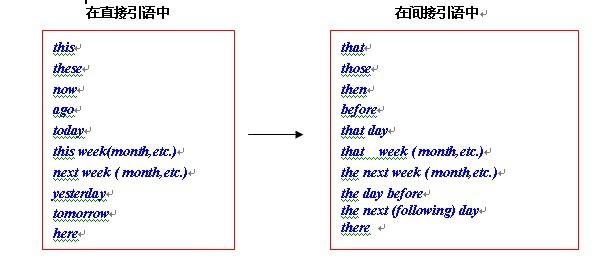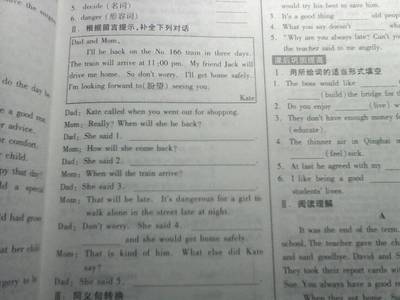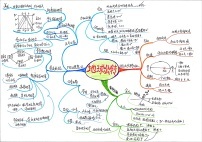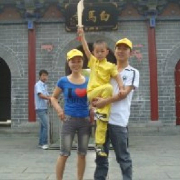直接引语转换间接引语的解析

直接引语和间接引语
一、 间接引语的概念和变化规律
1、间接引语是用自己的话去转述别人的话。
引用或转述别人说的话时,采用两种形式:一是一字不改地将别人的话加以引用,这叫直接引语;二是用自己的话加以转述,这叫间接引语。一般来讲,直接引语须放在引号内,间接引语不必用引号,而且多用宾语从句的形式表达。例如:
She said, “I was ill yesterday.”
→She said that she had been ill the day before.
由以上例句可以看出,直接引语变为间接引语时,不仅把直接引语变为宾语从句,增加连词that,而且还需相应地改变代词、动词和状语。如I 变成了she,was变成had been,yesterday变成the day before。
2、直接引语变为间接引语时,人称代词要根据转述人的立场作相应变动。
人称代词的变动情况要根据语境及转述人的不同作相应变化,一般情况下,与汉语中的变化相同。可记住一个口诀:“一主、二宾、三不变”。即第一人称按照主句中的主语变化,第二人称按照主句中的宾语变化,第三人称一般不需要变化。例如:
1) He said, “I am glad to see you.”
→He said that he was glad to see me.
2) “Do you know the man over there?” Mary said to Tom.
→Mary asked Tom if he knew the man over there.
3) Jim said to me, “Jane left her schoolbag at home.”
→Jim told me that Jane had left her schoolbag at home.
3、间接引语中动词时态的变化。
1)当引述的动词为现在时形式时,间接引语中的动词时态不变。例如:
Tom says, “Our teacher is kind to us.”
→Tom says that their teacher is kind to them.
2)当引述的动词为过去时形式时,间接引语中的动词作如下变更:
一般现在时→一般过去时 过去进行时→不变
一般过去时→过去完成时 将来进行时→过去将来进行时
一般将来时→过去将来时 现在完成时→过去完成时
现在进行时→过去进行时 过去完成时→不变
He said, “I will leave for Beijing tomorrow.”
→He said that he would leave for Beijing the next day.
如果所转述的内容表示客观真理或有表示某一绝对具体的过去时间作状语,间接引语中动词的时态不变。例如:
The teacher said, “The earth is round.”
→The teacher said that the earth is round.
He said, “I was born in 1980.”
→He said that he was born in 1980.
4、直接引语变为间接引语时,指示代词、时间状语、地点状语和表示“方向”动词的变化。
this → that, these → those; now → then, today → that day, tomorrow → the next (following) day, next week → the next week, yesterday → the day before, last night → the night before, ago → before; here → there; come → go.
如果在当地转述, here不必改为there, 动词come不必改为 go; 如果在当天转述,yesterday,tomorrow等时间状语也不必改变。例如:
Kate said, “I will come here tomorrow to help these children with their English.”
→Kate said that she would go there the next day to help those children with their English.(不是在当天当地转述)
→Kate said that she will come here tomorrow to help these children with their English.(在当天当地转述)
二、当直接引语是陈述句时
直接引语是陈述句时,间接引语用that引导,但在口语中that可以省去。从句中的人称、时态、指示代词、时间状语和地点状语等要作相应的变化。例如:
She said to me, “I came back an hour ago.”
→She said to/told me that she had come back an hour before.
三、当直接引语是一般疑问句、选择疑问句、反意疑问句时
1、原句若为一般疑问句时,用whether或if 转述;原句若为选择疑问句时,用whether…or…/…or not;原句若为反意疑问句,则常用whether或if 转述。
2、疑问句语序变为陈述句语序。
3、主句中的谓语动词为said时,要改为asked;没有间接宾语时,可以加一个间接宾语(如me,him等)。
4、句末用句号。
5、从句中的人称、动词时态和状语等也要作相应的变化。
He said, “Are you interested in English?”
→He asked (me) if /whether I was interested in English.
I asked him, “Will you stay at home or go to a film tonight?”
→I asked him whether he would stay at home or go to a film that night.
“You’ve already got well, haven’t you?” she asked.
→She asked (me) whether/if I had already got well.
四、当直接引语是特殊疑问句时
如果直接引语是特殊疑问句,改为间接引语时,仍用原句中的wh-类的词引导,其余的变化同直接引语为一般疑问句的情况2—5条一样。例如:
“What is your name?” he asked me.
→He asked me what my name was.
He asked: “Where are you to get off, Peter?”
→He asked Peter where he was to get off.
如果在直接引语的特殊疑问句中,疑问词作主语或主语的修饰语,则语序不需要变化。例如:
“Whose picture is the most beautiful in your class?” asked the boy’s father.
→The boy’s father asked him whose picture was the most beautiful in his class.
五、当直接引语是祈使句时
直接引语为祈使句,变为间接引语可用如下的结构“主语+asked/advised sb. (not) to do sth.”。
1、需将原祈使句中谓语动词变成不定式。如果祈使句为否定句,则用不定式的否定形式,即在不定式前加not。
2、原主句谓语动词said须改为asked,told,ordered,warned或advised等含有祈使意义的能带宾补的及物动词。
3、原句有“please”时,主句谓语多用asked(请求),并去掉please。例如:
He said to me, “Shut the window, please.”
→He asked me to shut the window.
He said, “Don’t make so much noise.”
→He told us not to make so much noise.
如果以let开头的祈使句表示劝告或建议,可用“suggest + that从句”或“suggest doing”来转述。例如:
“Let’s go to the cinema.” Tom said.
→Tom suggested that they (should) go to the cinema.
→Tom suggested going to the cinema.
六、直接引语是感叹句时
直接引语是感叹句变间接引语时仍可用what或how引导,词序不变,也可用that 引导,将句子变成相应的名词性从句。例如:
She said, “What a lovely day it is!”
→She said what a lovely day it was.
→She said that it was a lovely day.
直接引语和间接引语练习题
将下列句中的直接引语改为间接引语
1. I said to/ordered my boy, “Go home.”
2. The doctor said to her, “Don’t eat too much fat.”
3. “Have you any difficulty?” he asked me.
4. He said/asked, “Is she coming?”
5. He said/asked, “Where have you been?”
6. “Why didn’t you tell me earlier?” I asked her.
7. He asked me, “How long will it take to go there by plane?”
8. He told/said to me, “Abraham Lincoln was born on February 12, 1809.”
9. He asked me, “Do you study English or French?”
10. He said, “How happy I am!”
 爱华网
爱华网



